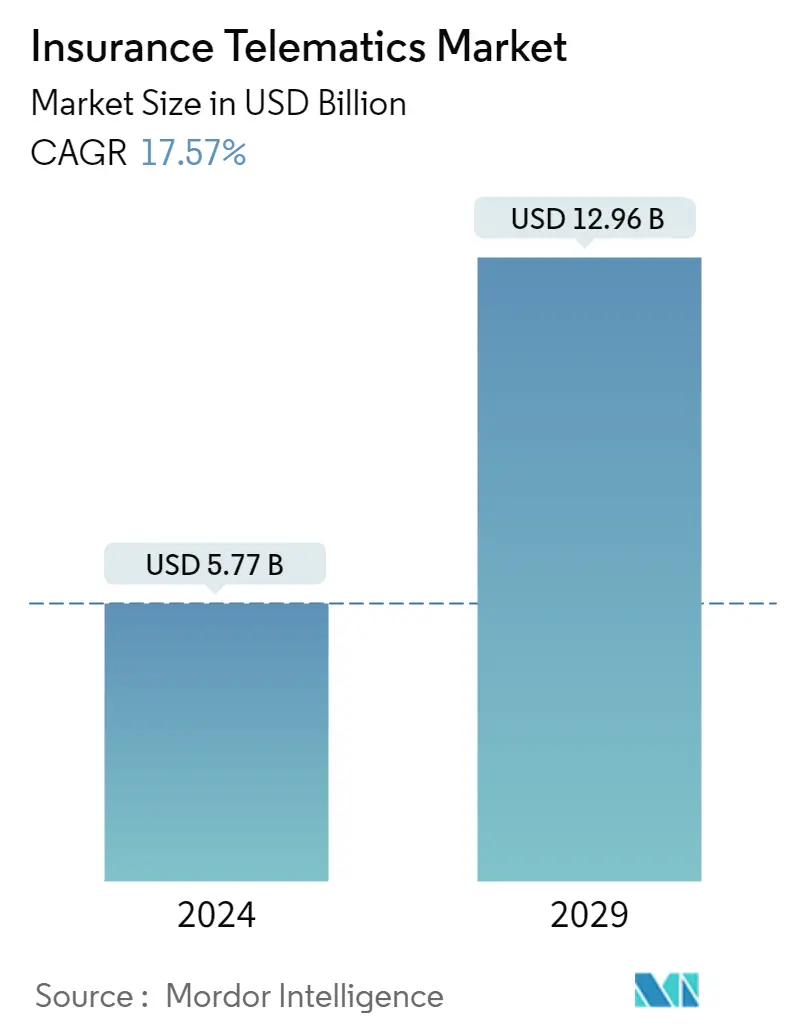Market Size of Insurance Telematics Industry

| Study Period | 2022 - 2029 |
| Market Size (2024) | USD 5.77 Billion |
| Market Size (2029) | USD 12.96 Billion |
| CAGR (2024 - 2029) | 17.57 % |
| Fastest Growing Market | Asia-Pacific |
| Largest Market | Europe |
Major Players
*Disclaimer: Major Players sorted in no particular order |
Need a report that reflects how COVID-19 has impacted this market and its growth?
Insurance Telematics Market Analysis
The Insurance Telematics Market size is estimated at USD 5.77 billion in 2024, and is expected to reach USD 12.96 billion by 2029, growing at a CAGR of 17.57% during the forecast period (2024-2029).
As part of how telematics insurance usually works, a "black box" is installed in the car. This device keeps track of things like speed, distance, and the type of route taken.
- Additionally, this device tracks braking behavior and driving habits, which insurance companies use to determine a fair price. Insurance telematics can improve claims, risk selection, and fraud detection while changing the current motor insurance landscape.
- Telematics can be understood as a combination of informatics and telecommunication. Telematics is helpful in the auto insurance sector for tracking, storing, and transferring driving-related data. This data is beneficial for understanding driving behavior and setting reasonable auto insurance prices. Consumers enjoy real-time services like crash assistance. These services support the growth of bold claims services and assist insurers in driving digital use.
- The usage of cloud services in insurance telematics is being driven by the Internet of Things (IoT) integration in passenger and commercial vehicles. For instance, a parent can monitor their kids' driving behaviors. Cloud services may be incorporated into the customer experience with third-party applications, fueling the market's expansion throughout the forecasted period. The use of smartphones is growing, and its integration with cloud telematics enables real-time data exchanges that maintain track of vehicle operations and reveal insights and hazards associated with a driver's driving style. Better data and device management are made accessible by the cloud deployment of insurance telematics.
- Usage-based insurance (UBI) is widely available for vehicles in developed countries, which is a driving factor for the insurance telematics market. In this UBI, the payable premium for the policy is directly linked with the insured product or service usage. For consumers, it will promote safe driving, resulting in the mitigation of accident severity and frequency. For the insurers, the claim-handling cost will be reduced by 55%, likely driving market growth over the forecast period.
- Many automobile industry firms have already begun investing in cutting-edge telematics systems to gain a competitive edge. Fleet managers can obtain a wealth of information about the condition of their cars from application-specific telematics and computer imaging. But the market may be limited by problems with data quality and compatibility caused by internal and external damage, installation time, and regular updates.
COVID-19 had a profound impact on the claims functions of insurance companies around the globe. On the one hand, the number of claims had increased significantly, with many relating to new or unusual situations in these unprecedented times. However, in the current conditions, the shift towards non-COVID claims has risen in the sectors of health and motor, according to ICICI Lombard General Insurance, which indicates the growing need for insurance in the telematics market.
